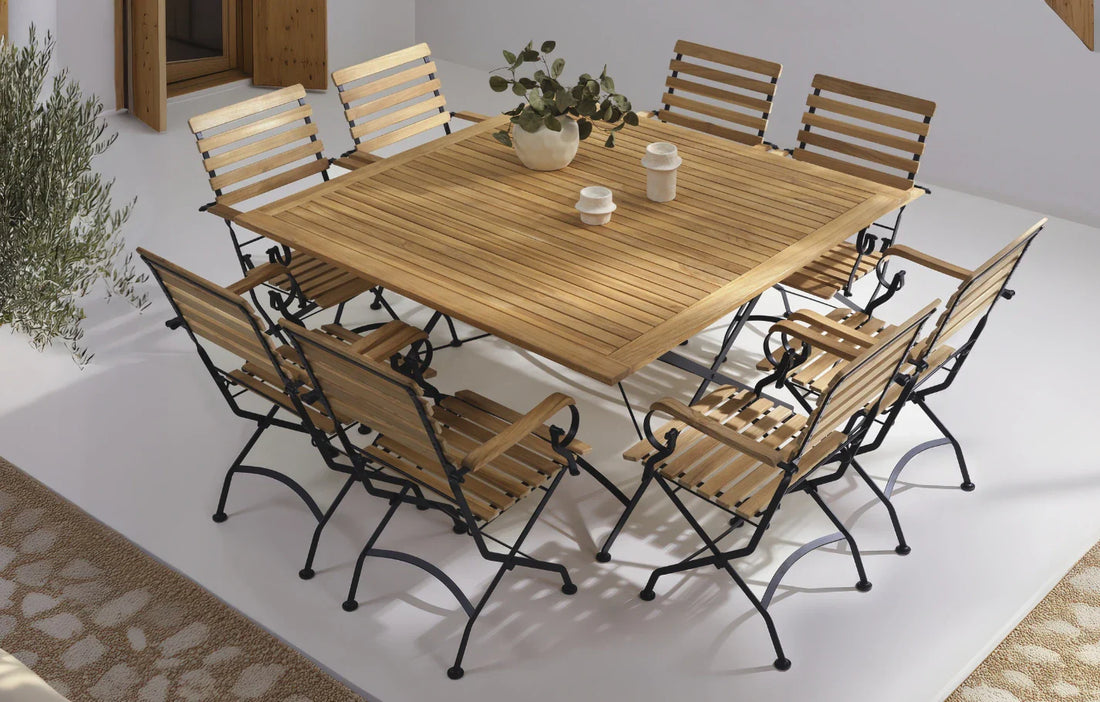
Solid Wood vs “Wood Effect: How They Trick Your Eyes
Share
That wooden garden dining table you spotted online? Chances are, it may not be solid anything.
Outdoor furniture brands have turned looking like wood into a high art. Let’s peel back the layers—literally—and expose how many “wooden” patio sets are actually MDF and plastic in disguise.
The Outdoor “Wood Effect” Illusion
Marketing loves phrases like:
“Real-wood feel”
“All-weather oak finish”
“Premium teak look”
None of these guarantee solid timber. They usually mean a cheaper core—MDF or particleboard—wrapped in something prettier and questionably weatherproof.

Veneer Garden Furniture: The Real Truth
A veneer is a razor-thin slice of real wood glued onto an MDF or plywood base. While this is often marketed as a genuine wood surface with a stable construction, it is usually a very thin piece of wood which can be prone to weather-related wear and tear quicker than its solid counterparts.
It's also crucial to remember that veneer garden furniture cannot be sanded or refinished- any attempts to sand down your veneer table top and you'll hit the MDF immediately.
Laminate: Printed Wood (And Its Problems)
Laminate is essentially a high-res photo of wood under clear plastic.
Totally synthetic, no natural grain.
UV light fades the printed layer over time, so it's not a material you'll see used regularly in outdoor furniture.
Chips expose the white or grey core beneath.

MDF & Particleboard: The Hidden Core
Medium-Density Fibreboard and particleboard are compressed sawdust with glue—and moisture is their enemy.
Even “sealed” MDF swells like a sponge if rain or humidity get through.
Heavy to move, but nowhere near as strong as real hardwood.
Often called engineered wood to sound fancy.
Know What's What Before You Buy a Garden Furniture Set
When you’re eyeing that wooden outdoor sofa set or wooden garden bench, check:
✅ Underside & Edges: Look for a different material or plastic edging—dead giveaway for veneer or laminate.
✅ Weight & Feel: Solid hardwood is heavy but has natural variation; MDF is uniform and oddly dense.
✅ Joinery: Real timber uses mortise-and-tenon or dowels. Cam locks and staples often mean flat-pack.
✅ Ask the Hard Question: “Is every part 100% solid teak/acacia?” Don’t settle for “teak finish.”
Why Do Retailers Choose the Cheaper Option?
Cheaper to ship than solid wood.
Cheaper for customers in the current climate where many buyer's budgets are stretched.
Bigger profit margins—due to the expense of solid wood alternatives.
Fast fashion appeal: quick production and seasonal colour updates.
And as long as they avoid the literal words “solid wood throughout,” they’re legally in the clear.
When Engineered Options Make Sense
It's important to remember that not all composites are villains:
✅ Quality plywood + thick veneer can be stable if kept under cover.
✅ High-pressure laminates work on small side tables if you need easy-clean surfaces.
Just make sure the price matches the material, not the marketing story.
FAQs About Wooden Garden Furniture
Can veneered outdoor tables last?
Only if kept under a covered patio and maintained. Direct rain will ruin them.
Is acacia finish” the same as acacia wood?
No. It’s often MDF or pine with a thin decorative film. Unless something explicitly states it's solid wood, it's safe to assume it likely isn't.
Best wood for genuine outdoor use?
I always recommend teak, eucalyptus, or well-treated acacia—always solid and sustainably sourced.
The Bottom Line
“Solid wood” should mean solid all the way through—especially for furniture that lives outside in sun, rain, and frost. Before you spend on that dreamy garden dining set or wooden garden sofa table, flip it over, run a hand along the underside, and ask the blunt question.
Because when the summer storms hit, only true solid timber will survive—and only the informed buyer avoids a soggy, swollen disappointment.
